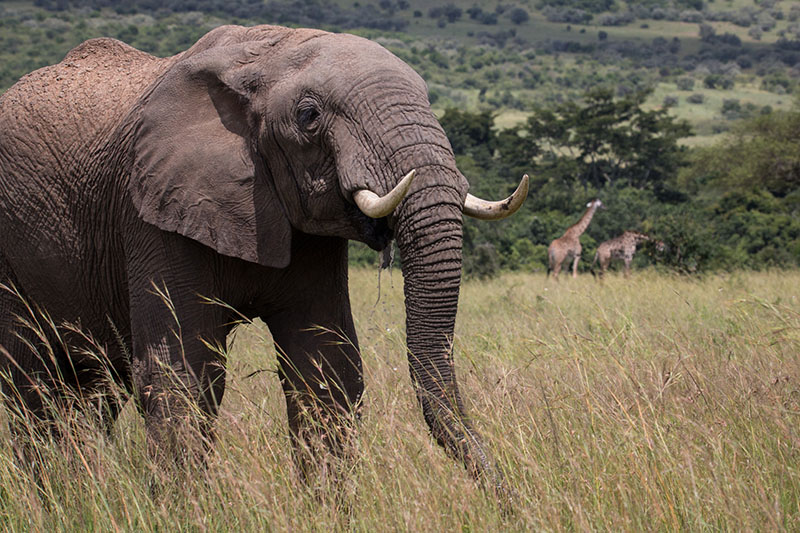There is no single best time to visit East Africa but there are rainy and dry seasons. Each has its advantages and each destination has its best moments, not least in the Masai Mara/Serengeti where the seasonally-driven wildebeest migration takes place.
If you have already decided when you are going on safari, it’s now time to choose where to travel to; if your dates are flexible, you can plan your safari better by understanding East Africa’s seasonal trends.
We’ve split the year up into three periods to coincide with the main phases of the wildebeest migration and the rainy seasons.
DECEMBER TO MARCH
Expect warm temperatures and short rains. Game viewing in the Serengeti, diving in Zanzibar and gorilla trekking in Uganda and Rwanda are excellent choices now.
Weather: This is summer in East Africa. Temperatures are warm and pleasant with an average high of 28°C and an average low of 15°C. The rains from early November to late March are usually scattered and localised with short-lived downpours. There is often heavy rain in late March.
Where to go:
- The SerengetiAs the mid-November rains begin, the wildebeest herds move onto the southern and eastern plains of the Serengeti and the northern Ngorongoro Crater Conservation Area. If you want to see predators in action, the February calving season provides plenty of drama.
- Lake NakuruIn terms of birdlife, Kenya’s Rift Valley lakes are at their peak in January and February. Flamingos gather at Lake Nakuru in their hundreds of thousands and the pink mass they create is a pinch-me-I’m-dreaming spectacle.
- Mount KilimanjaroIf you want the best conditions to climb Africa’s highest peak, go during warm and dry January and February.
Mount Kilimanjaro Tour Deals
- Gorilla Trekking in Rwanda & UgandaLate December to early March sees the driest weather in Uganda and Rwanda: gorilla treks are easier and the views better.
- ZanzibarVisit between late December and early March. Temperatures are a little higher than during the cooler and drier late June to October period but it’s less crowded and you’ll get better deals on accommodation and air fares.
APRIL TO JUNE
Don’t be put off by the long rains: safaris are still good in the Serengeti, Lake Manyara and Masai Mara. It’s also less expensive and popular destinations are less crowded.
Weather: The long rains arrive and heavy showers can be expected for a few hours every day or so. Avoid the hot and humid East African coast at this time as well as Uganda and Rwanda – rain is torrential.
Where to go:
- Southern & Central SerengetiWith the wildebeest herds forming huge, noisy columns in preparation for their trek, April, May and June are the best months for game viewing in the southern and central Serengeti and the northern Ngorongoro Crater Conservation Area.
- Ngorongoro CraterProviding some of Africa’s best Big 5 game viewing, the Ngorongoro Crater is excellent year round; the main factors for planning your trip here are weather and visitor numbers. From April to June the crater will be lush and green and you’ll have much of the place to yourself.
JULY TO NOVEMBER
Mild temperatures and classic dry-season game viewing make these months a popular time to visit East Africa. Book accommodation and tours well in advance, especially if it’s the wildebeest migration you want to see. Visitor numbers peak in August.
TOP PLACES TO VISIT IN KENYA
Weather: The October to December short rains in Tanzania and central Kenya notwithstanding, these months are mostly dry and sunny forcing animals to gather at permanent water. July to September offers the most pleasant weather in East Africa, especially along the coast.
Where to go:
- Western SerengetiBy early July the wildebeest and zebra herds have arrived in the western Serengeti and the Grumeti Reserves. Not only are big cats highly visible at this time but this is when the herds have to cross crocodile-infested rivers – prepare for Jurassic-style drama.
- Northern SerengetiAs the dry season wears on, the animals move across the northern Serengeti as they make their way back to the Masai Mara though the Mara River has to be crossed first. Game viewing in this region is now excellent.
- Masai MaraBy mid-August, the herds have flooded Kenya’s Masai Mara where they remain until early October. This is when game viewing in the Masai Mara is at its peak.
- Gorilla trekking in Uganda & RwandaIf you can’t go gorilla trekking in January and February, the next best option is to go in the relatively dry months of June to August.
- Mount KilimanjaroSeptember is a great month to climb Kilimanjaro but so are July and August if you don’t mind colder temperatures.
- ZanzibarThe coolest and driest time to visit Zanzibar is between late June and October – great for families – but this is also when the island is at is busiest and accommodation rates and air fares are at their peak.
Tarangire National Park Smaller and less visited than the Serengeti and Ngorongoro Crater, Tarangire comes into its own from July to November when enormous numbers of animals are drawn to the life-giving Tarangire River. Elephant viewing is outstanding and your chances of seeing Africa’s top predators in action are high




Comment (0)